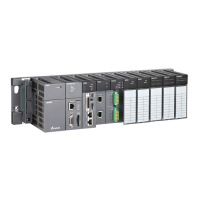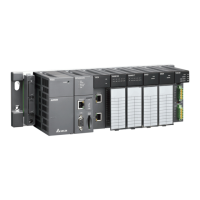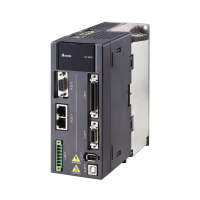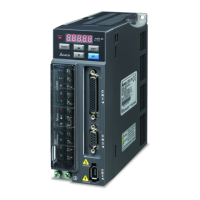AH500 Hardware and Operation Manual
11-36
11.2.1.2 Steps of Constructing an Ether Link
1. Plan a network architecture.
2. Connect PLCs to network cables according to the network architecture planned, and power the PLCs up.
3. Assign IP addresses and subnet masks to the Ethernet ports on the PLCs which will be involved in data
exchange by means of HWCONFIG in ISPSoft. (The PLCs which will be involved in data exchange must
be in the same domain.)
4. Create the network architecture planned in NWCONFIG in ISPSoft. Assign IP addresses and subnet
masks to the machines which will be involved in data exchange. (Note: The IP addresses/subnet masks
assigned in HWCONFIG and the IP addresses/subnet masks assigned in NWCONFIG must be the same.
Otherwise an error will occur if the Ether Link constructed in NWCONFIG is executed.)
5. Create a data exchange table. (Please refer to section 11.2.2 for more information.)
6. Download the data exchange table, and monitor the execution of the Ether Link constructed in
NWCONFIG.
7. The construction of an Ether Link is finished.
11.2.2 Constructing an Ether Link in NWCONFIG in ISPSoft
11.2.2.1 Constructing an Ether Link
Please refer to the example below for more information. If users want to create an Ether Link shown below,
they have to create a data exchange table for the two data request nodes AH-01 and AH-02.
(a) AH-01 reads the data in D100~D109 in AH-02, and stores the data in D0~D9 in itself.
(b) AH-02 reads the data in D200~D219 in AH-01, and stores the data in D110~D129 in itself.
An Ether Link is based on a network. If a node is connected to several networks, users can set several groups
of parameters related to Ether Links for the networks. As a result, there may be several groups of parameters
related to Ether Links in a PLC. Owing to the fact that an Ether Link is not a master/slave model, each node in a
network can be a data demanding node and a data supply node at the same time. In the first piece of data in
the table above, AH-01 is a data requiring node, and AH-02 is a data providing node. In the second piece of
data in the table above, AH-01 is a data providing node, and AH-02 is a data requiring node.

